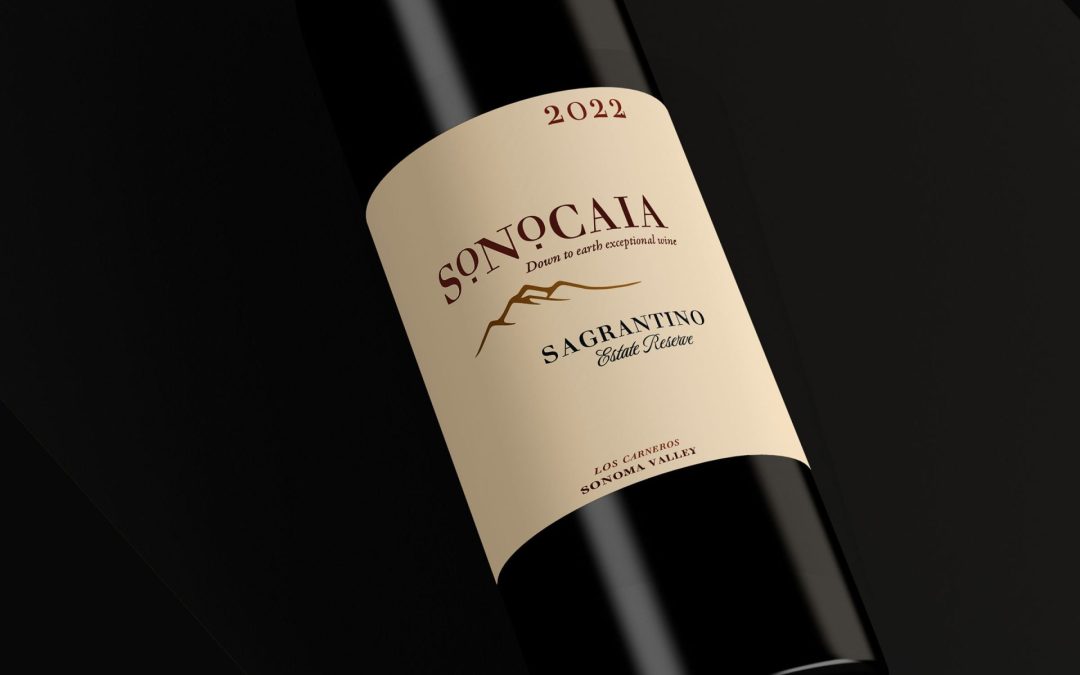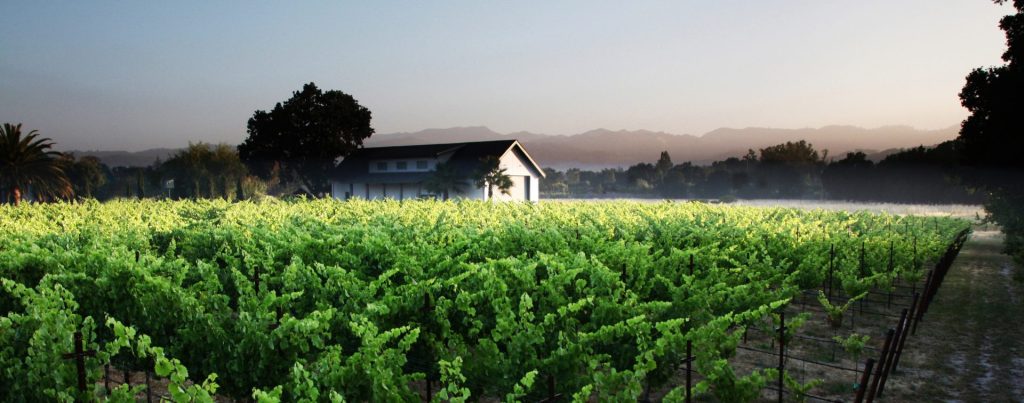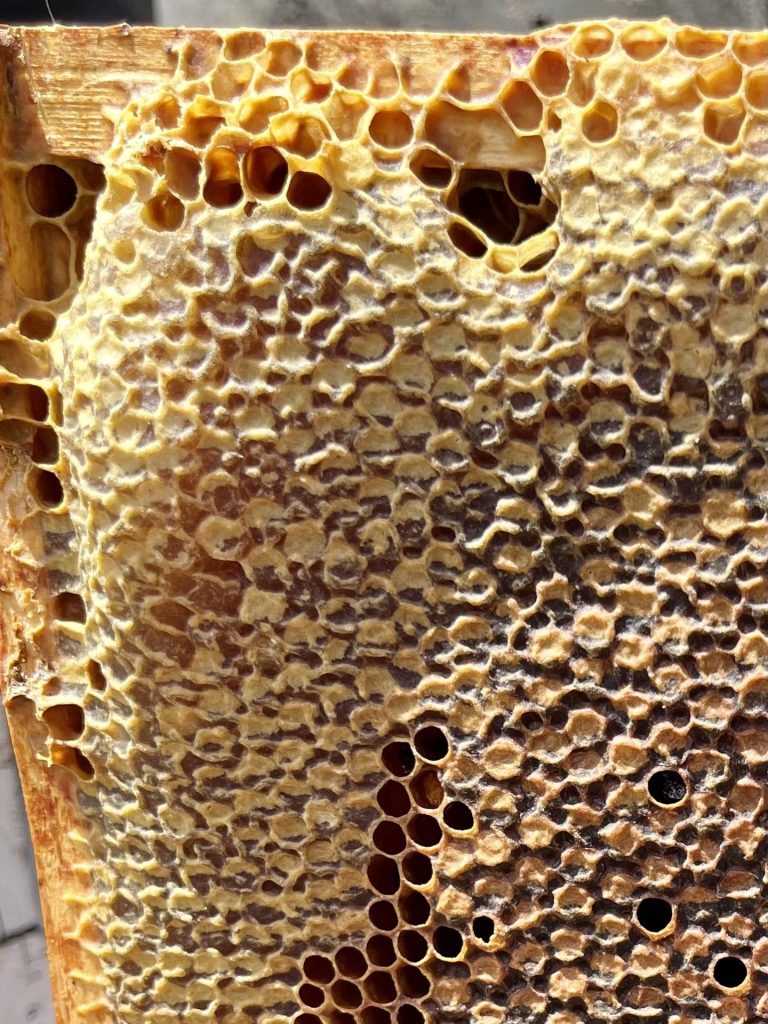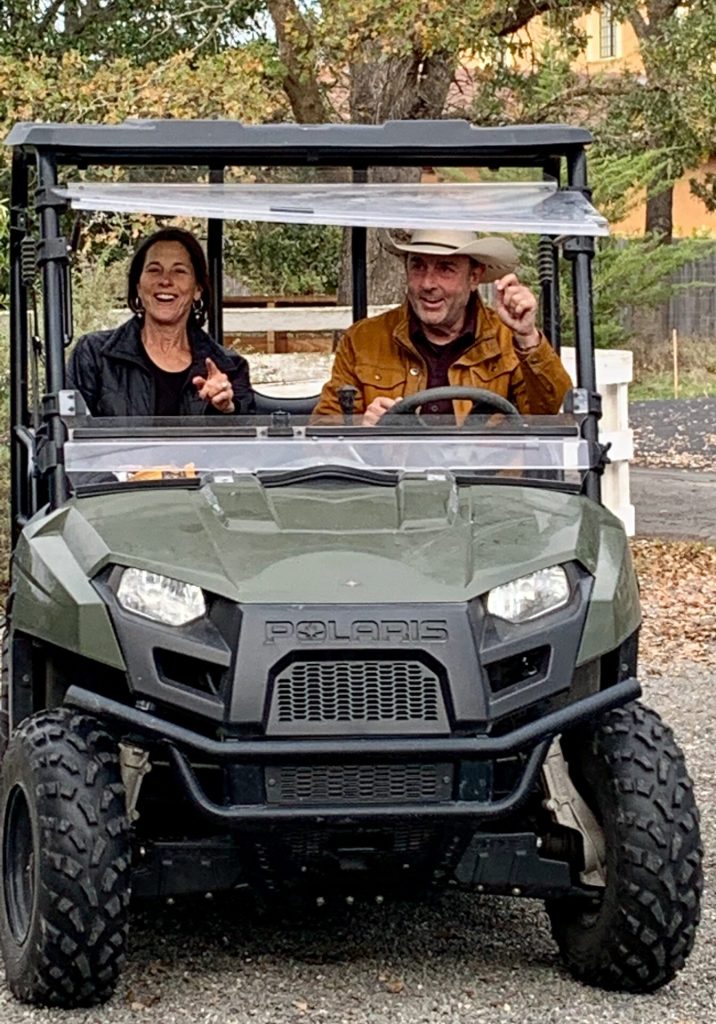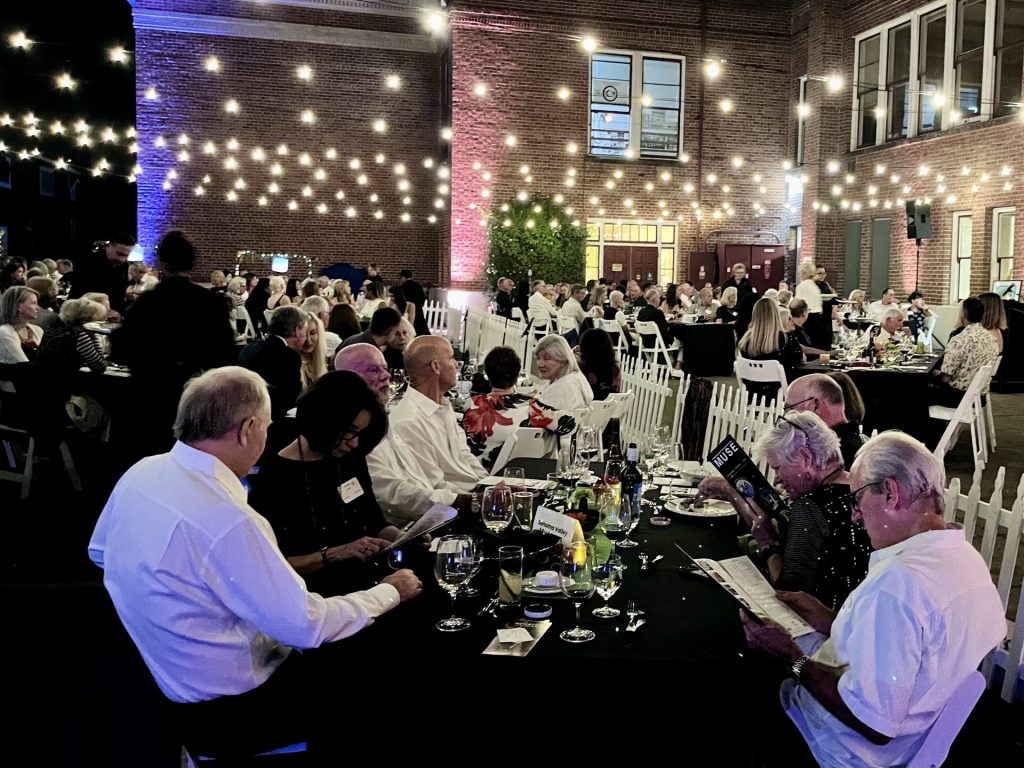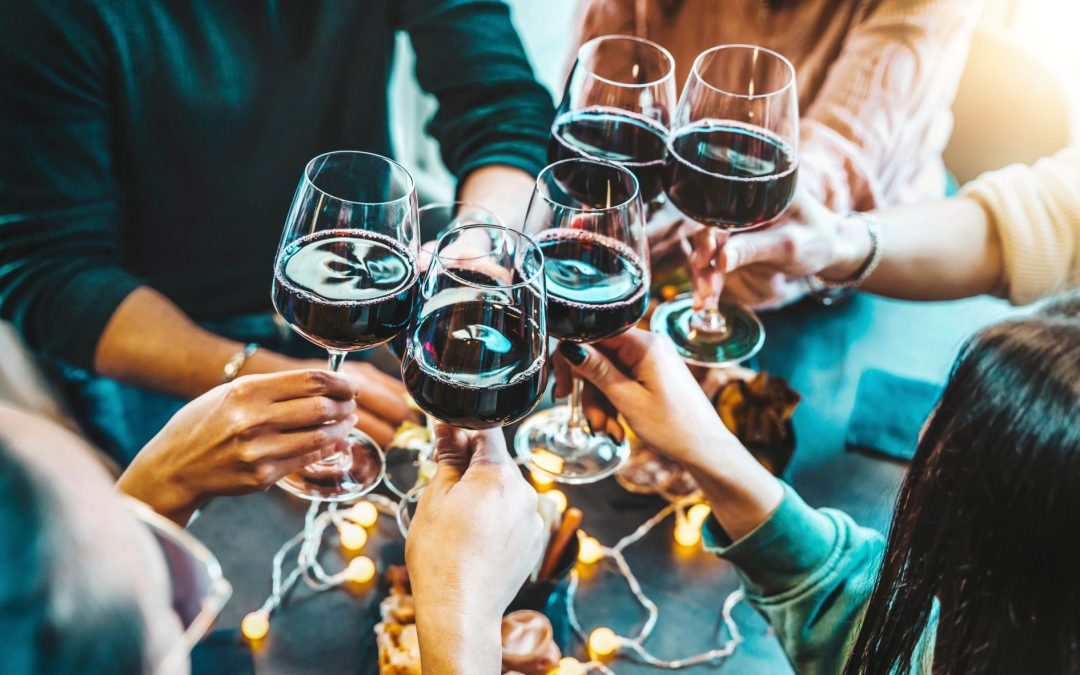
Feb 23, 2024 | Sonocaia, Sonocaia Estate, Sonocaia Estate Vineyard, Sonocaia Winery, Sonoma lifestyle, Sonoma Valley, Uncategorized
Thinking about booking a corporate event or a private family function? Our winery and farm might be just the right place…
Sonocaia is more than just a warm and inviting estate vineyard and boutique winery.
We’re also eleven acres of compelling ecological and agricultural projects.
Venues
We offer corporate team building functions and private family events, all mixed with learning about sustainable and eco-friendly practices. Explore the symbiotic relationship between nature and viticulture. Savor serious wines and farm-to-table produce while fostering a commitment to ecological and agricultural values. Schedule an educational seminar on a variety of grape, wine, and farming topics.
The winery and farm has a continuous and evolving set of projects underway at all times. Visitors are encouraged to inquire in advance about topics of interest.
Click here to inquire about booking your customized event
Catering
We partner with great chef-caterers offering delicious food options as part of your event plan.
Add an ecological or agricultural topic to your visit
Begin with a farm tour of bee hives, fruit orchards, and olive trees. Meet in the elevated pool house for a customized educational seminar. Take a stroll through the vineyard. Learn about composting, creek restoration, and surface water recovery. Or head straight to the winery to taste wine and enjoy a carefully curated chef’s meal.
In addition to grapes and wine, here are a few examples of the potential topics for your corporate or family visit:





Learn about estate Sagrantino, our special Umbrian red wine
Our estate grown Sagrantino is a boutique-scale effort; it is a traditionally-made deep red wine that transports tasters to the hills of Montefalco, Umbia, Italy. A rare find in California, this varietal is relatively unknown in the new world and is sparking curiosity from both the casual traveller and the serious wine critic. We have painstakingly cultivated our highly regarded Sagrantino vineyard over the years with careful sustainable farming practices. The resulting rich wine makes a bold but approachable statement.
Learn more about our estate Sagrantino here: information about Sagrantino
Shop for our Sonocaia estate reserve Sagrantino and other wines here: shop for wine now
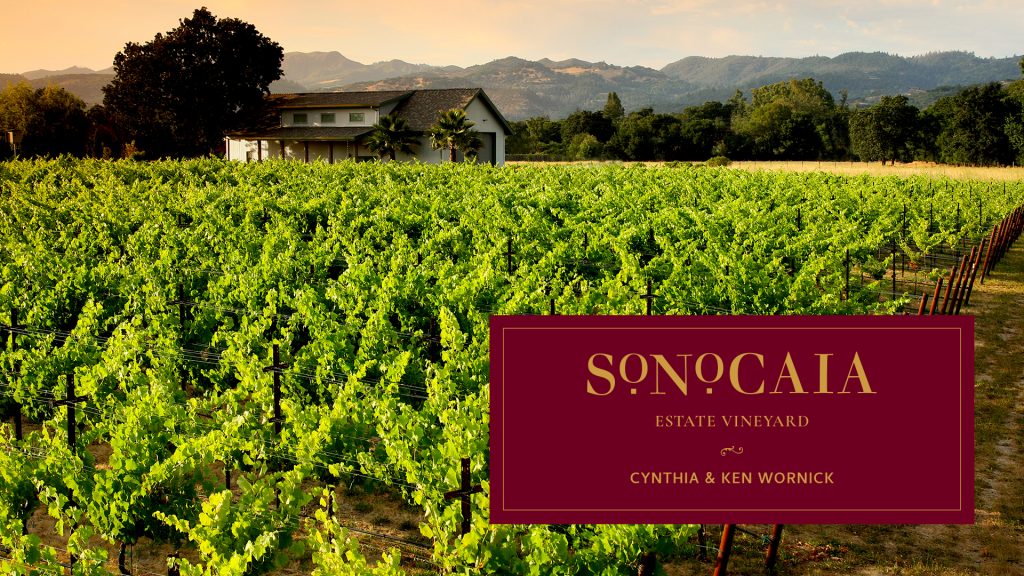
Or leave a message of inquiry for winery: 415-793-7985
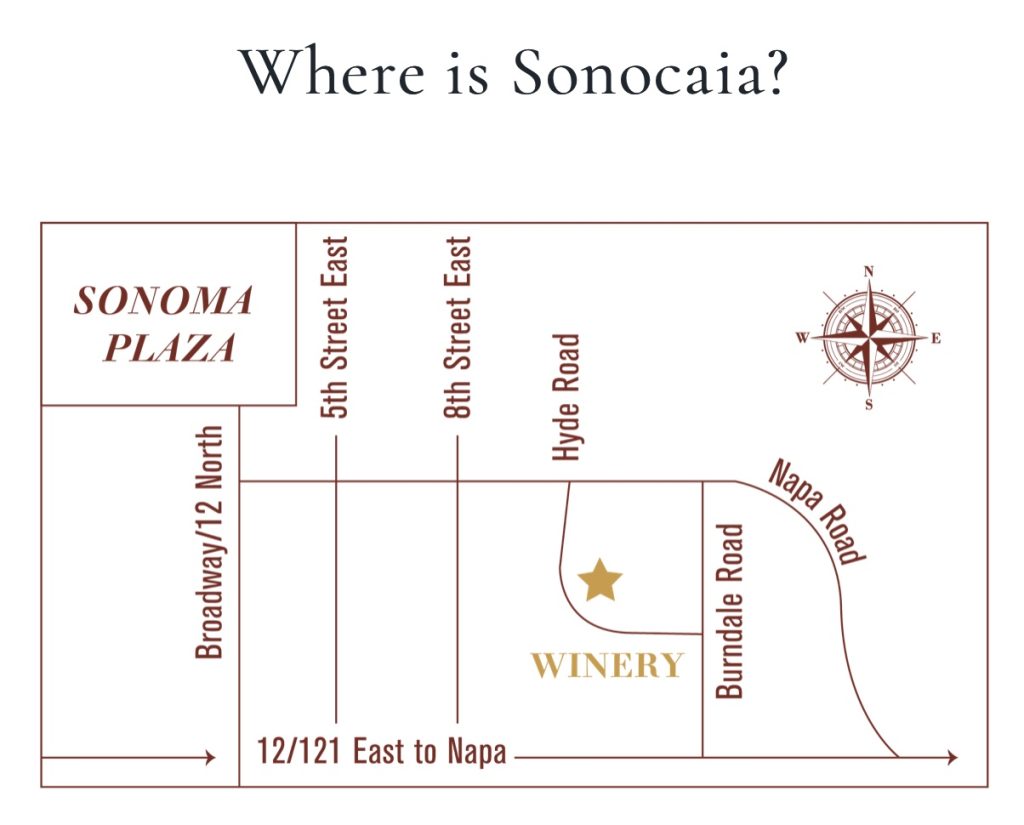
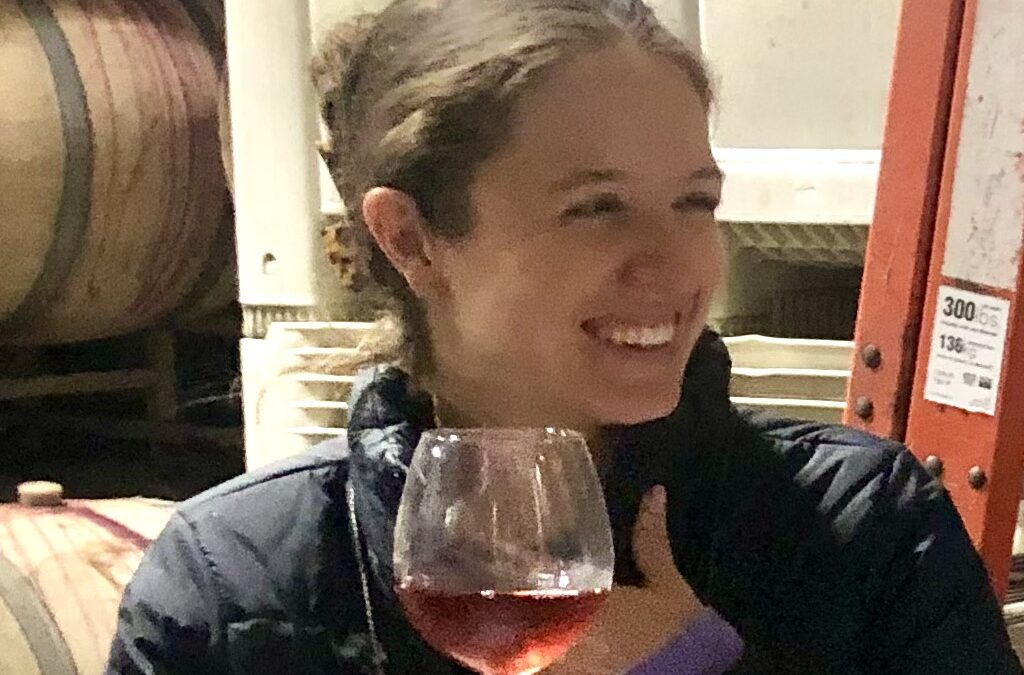
Jan 9, 2024 | Dysfunctional Family Winery, Sagrantino, Sonocaia, Sonocaia Estate, Sonocaia grand opening, Sonocaia Winery, Sonoma, Sonoma Farming, Sonoma International Film Festival, Sonoma lifestyle, Sonoma Valley, things to do in Sonoma
In case you missed this post, it is a fun review of the holiday season in Sonoma Valley and the Sonocaia winery. Give yourself 10 minutes to catch up with wine country. Warmly, Ken Wornick
Join us for a year-end wine country photo journey in our final Sonocaia blog post of 2023:
Locals tasting event
With the help of some very wonderful friends, we sold out another ‘grand opening’ winery event – mainly for locals that missed the initial launch of Sonocaia estate winery.
I presented a story of ‘wine in context’ – when tasting wine it is important to know “why” this wine was produced. In our case, we started almost twenty five years ago in the Santa Cruz Mountains developing vineyards for private clients. A decade later we had more than 40 vineyards built and were making a lot of personalized wine for those clients in our urban winery in Redwood City. Some of those wines won Gold and Double-Gold from the SF Chronicle wine competition. We sold the vineyard development and winery businesses to an investor. See this link for more. Over the next ten years, we built a second client-based vineyard development and wine making business, this time in Sonoma Valley. And sold that business in 2023. See this link for more.
Our newest project is the Sonocaia estate winery – focussed exclusively on Sagrantino, a rare red variety of very high repute from Montefalco Umbria Italy. Meanwhile, our second brand, Dysfunctional Family Winery, still lives on with the motto “serious wine, irreverent style” offering fun blends for all taste preferences and budgets. See link here.
A sold-out crowd enjoyed the stories, wines, food, and conversation…
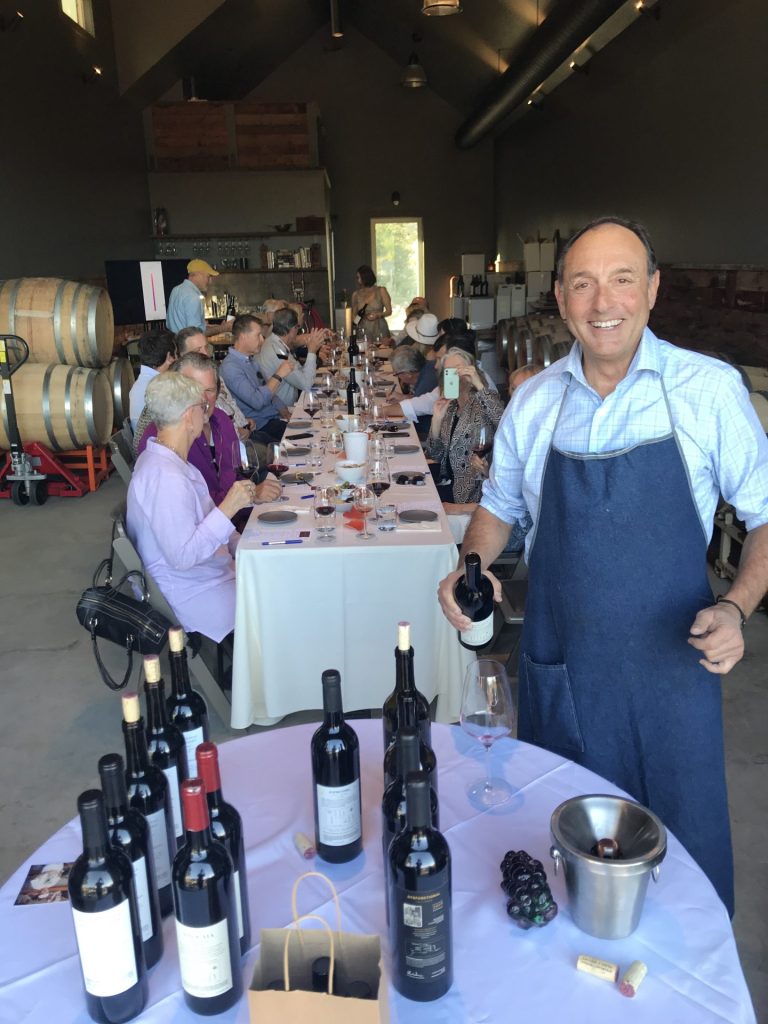
Working our way through the wine lineup
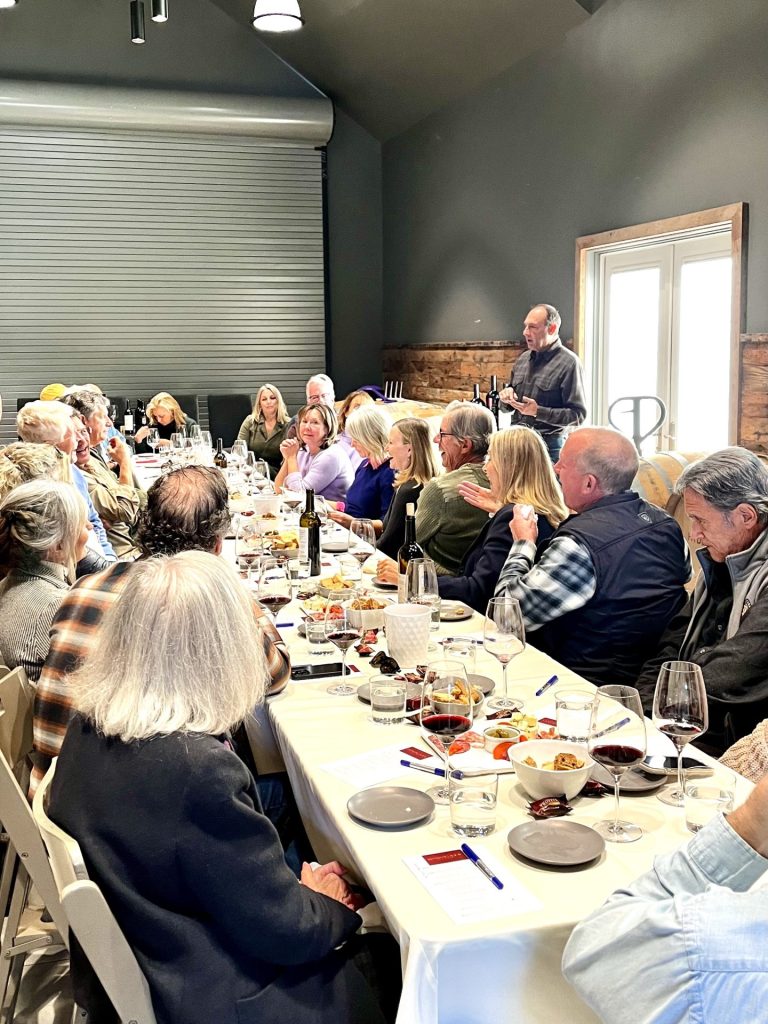
Answering a question about the unique clonal history of the Sonocaia Sagrantino grapevines
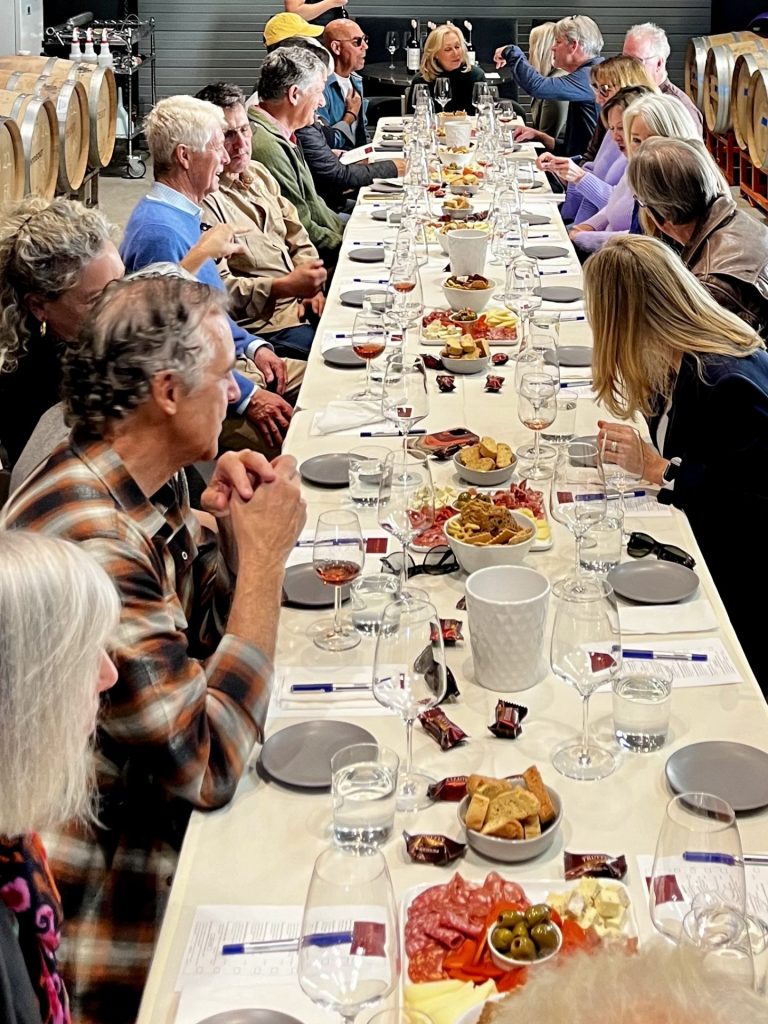
New friends being made all around the table
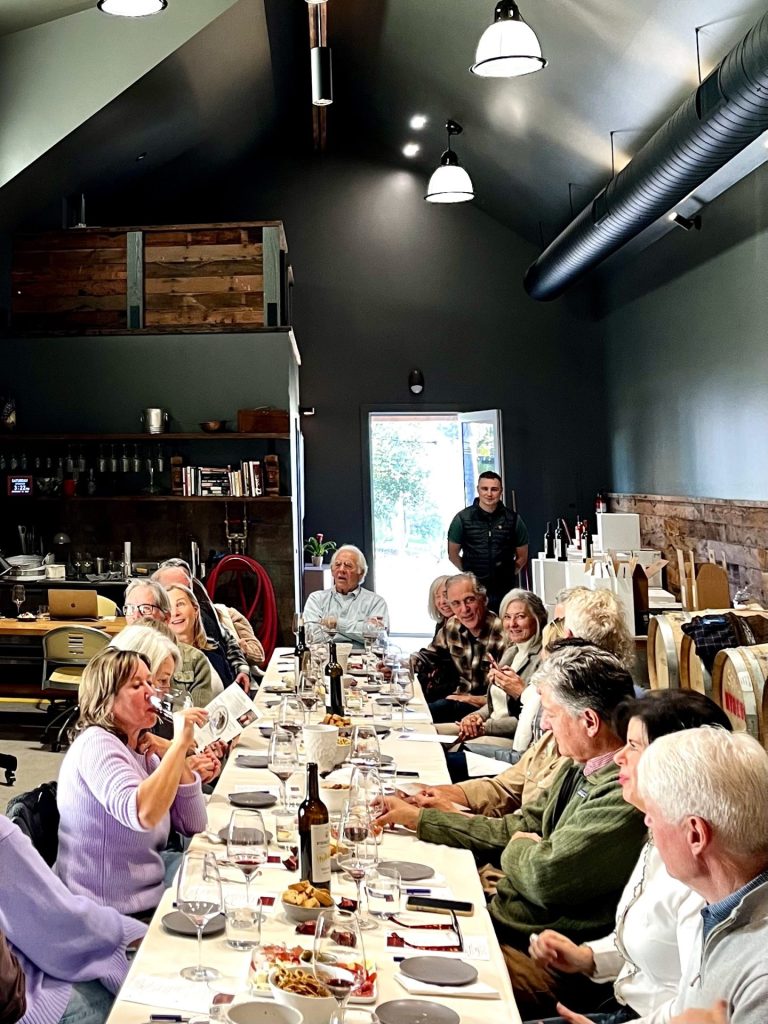
The tasting continues deep into the library wines
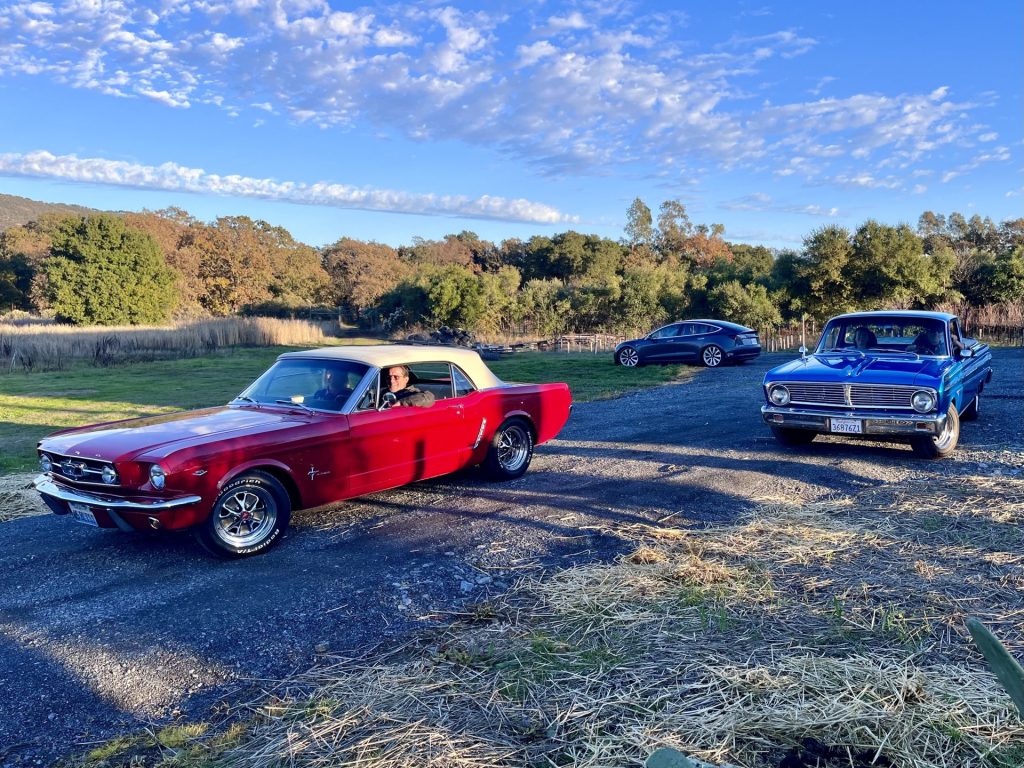
At the end of the tasting, a couple of wild local yahoos in their ridiculous jacked-up sport cars hit the gas and ripped up our nice new parking lot! Nah, not really, just kidding NF and GM.
But wait, there’s more…
A large, warm, and wonderful family from all over the U.S. (and three generations!) spent an afternoon with us the day after Thanksgiving ’23. We had a ball tasting through many wines, having lots of technical questions and answers about growing grapes and making wine, and generally having some great laughs. The toddler played with my guitar and beat a wine barrel with the drum sticks. Thank you Ginny and Larry.
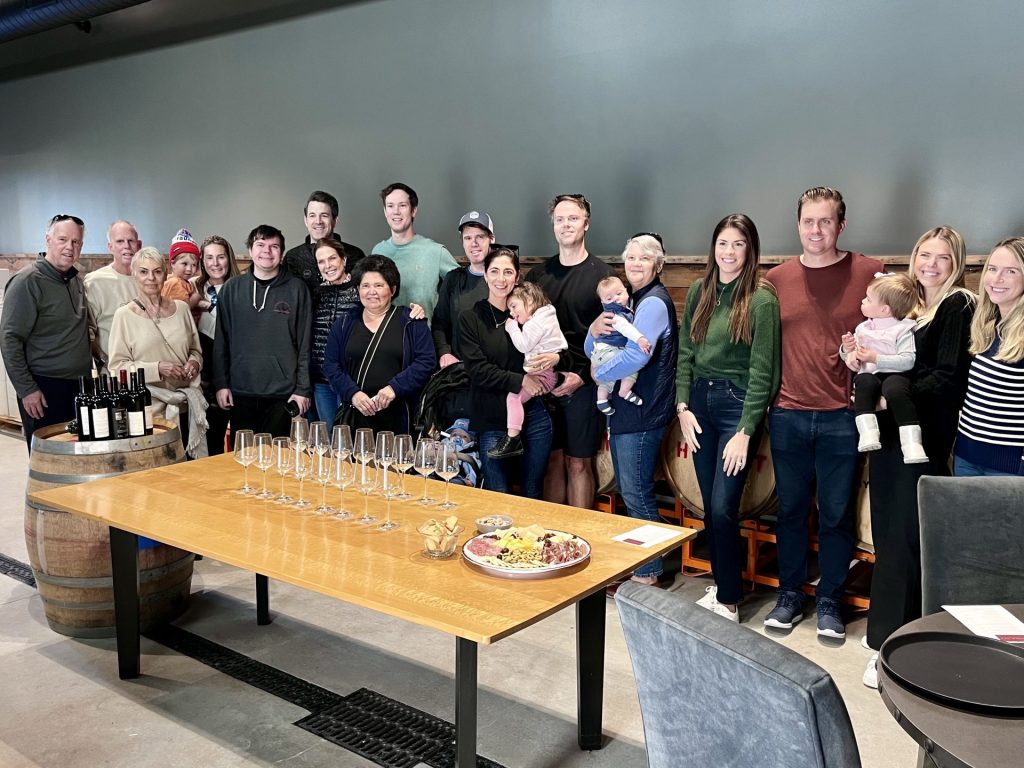
Sonocaia in the Sonoma Index-Tribune newspaper
Our local Sonoma newspaper took an interest in our new Sonocaia winery project. Find the full article here.The author, Emma Malloy, did a great job detailing the history of our winery project. They lead with this headline: More than a winery: Sonocaia, and agricultural gem.
KSVY 91.3FM Community radio
Our local radio station KSVY 91.3FM has great wall-to-wall programming including talk, music, news, food, politics, and so much more. Not everyone is aware of the quality of the programming, yet. I’ve been a frequent guest on station manager and KSVY Exec Director Bob Taylor’s “Morning Show” many times. If you are a Sonoma local, it is well worth tuning in and supporting. They recently launched a new transmission antenna and expanded their reach from Sonoma, now reaching into Petaluma, Novato, and Napa. And last month, KSVY held a very unusual fund raiser. At the vaunted and historic Sebastiani Theatre, built in 1933, five great bands played country and western music all afternoon to the hoots and hollers of a large crowd. Learn more about KSVY here.
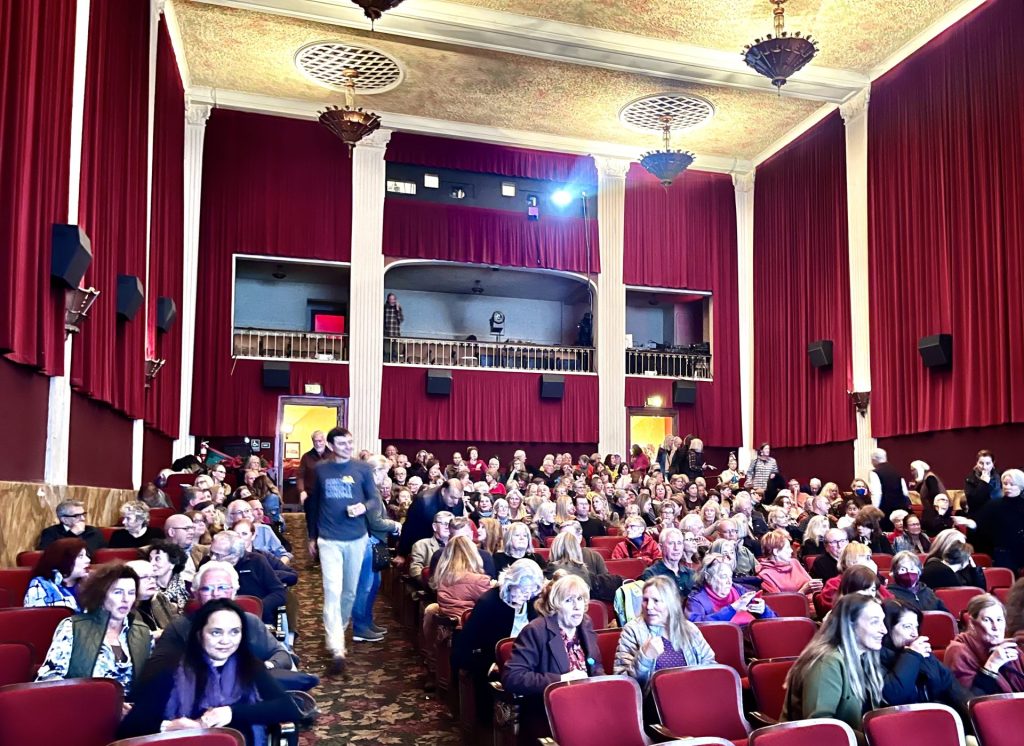
The crowd begins to gather at the Sebastiani Theatre
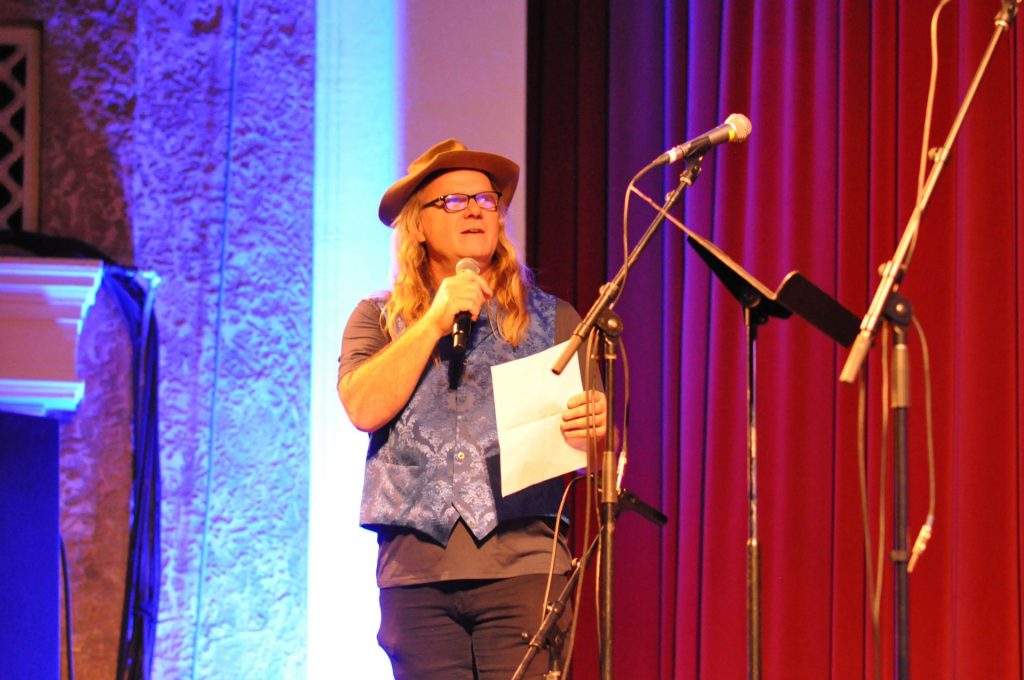
Bob Taylor, Executive Director of Sonoma community radio KSVY 91.3 (and lead guitarist of ACDC cover band “Illegitimate AC/DC”)
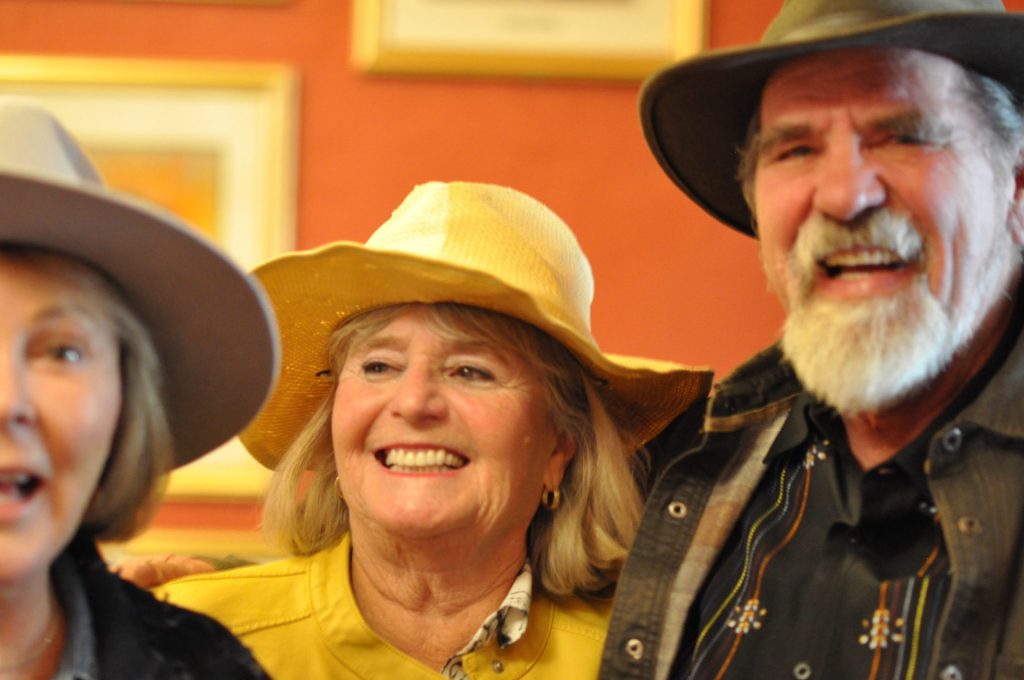
Patrons Diana Bugg and Leslie Carlson; and Roger Rhoten, widely beloved manager for over 30 years of the Sebastiani Theatre
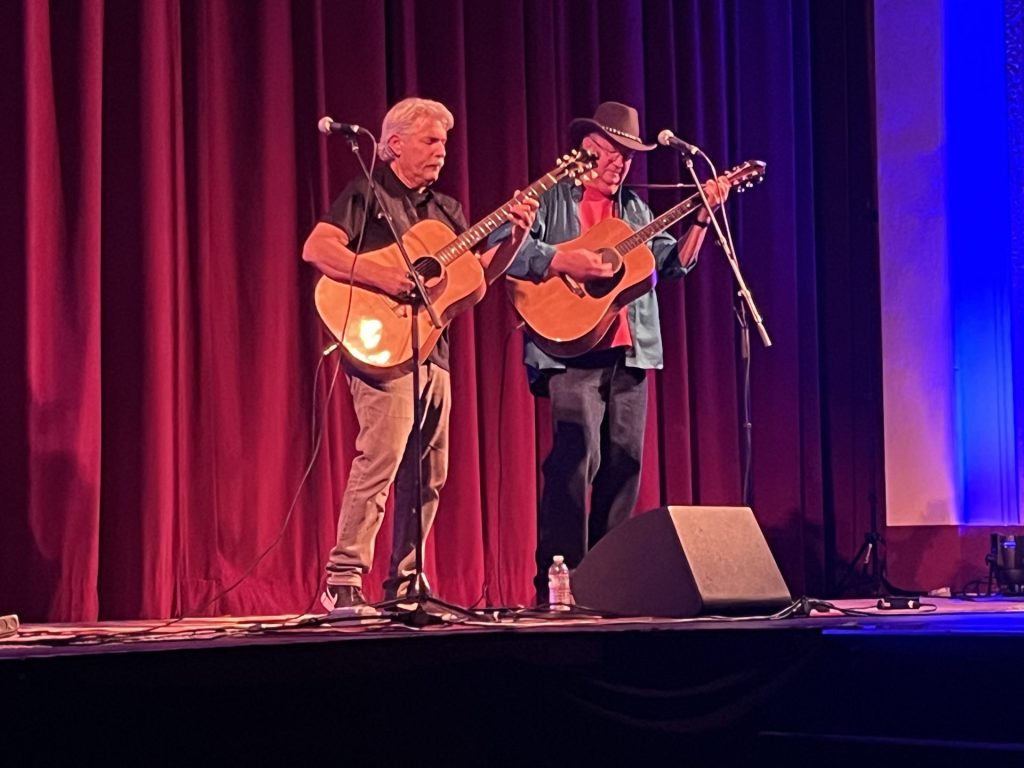
Sonoma Valley Museum of Art
SVMA, our treasured Sonoma art museum, situated on Broadway very close to the Sonoma Plaza, held a very fun ‘poetry, food, and wine’ event in the museum’s gallery. Sold out weeks in advance, the poetry was provocative, warm, and hilarious. A far cry from the sleepy prose that I recall from English class in 7th grade. I poured Sonocaia and Dysfunctional Family wines at the event. See more here. Carole Copelan poured her Owl’s Perch and Harpsichord wines. And Chef Kyle Kuklewski served some delicious bites which paired beautifully with the wines and the poetry. The art in the background in some of the images below are from Richard Mayhew and the exhibition is called Inner Terrain.
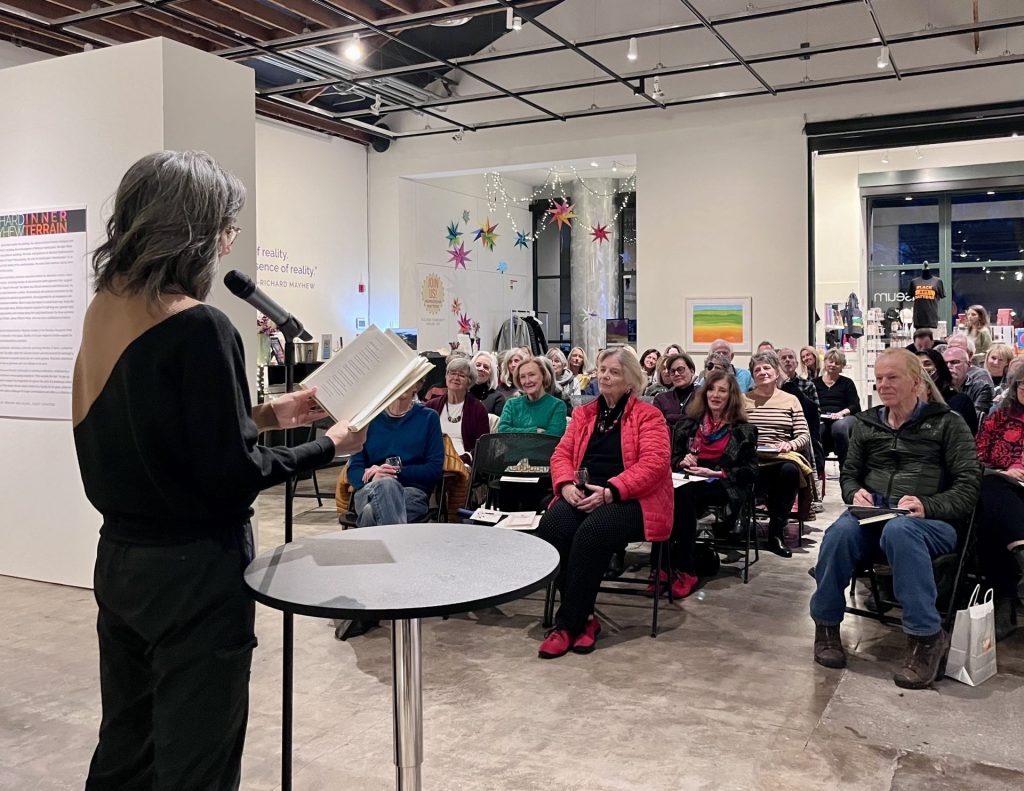
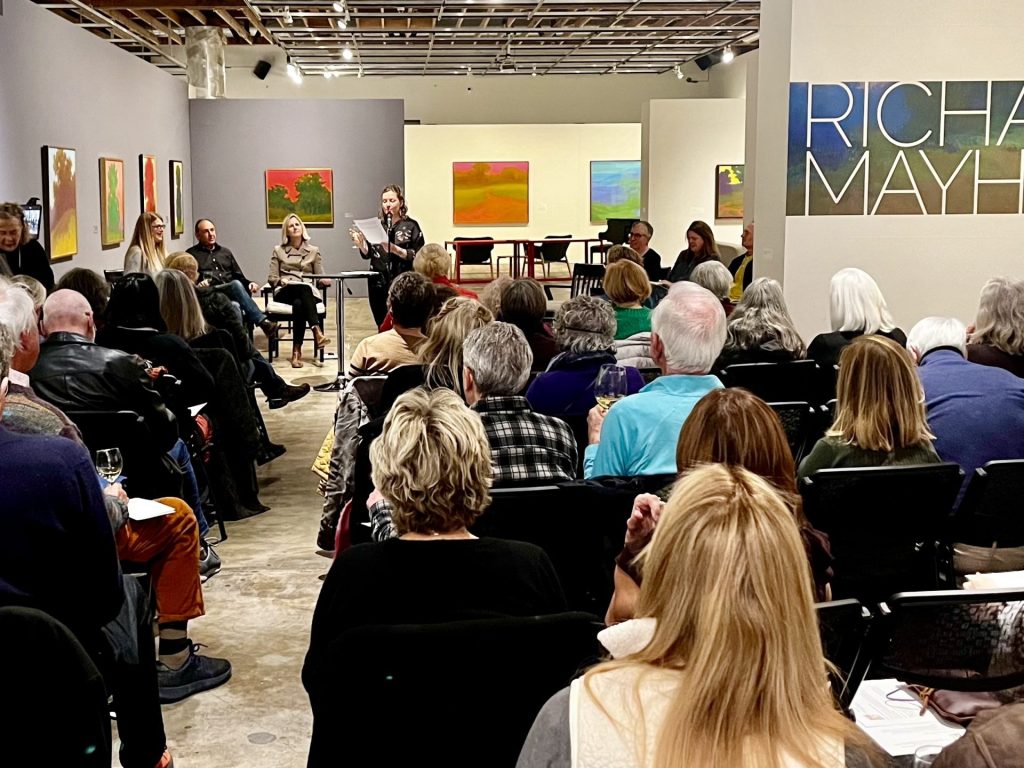
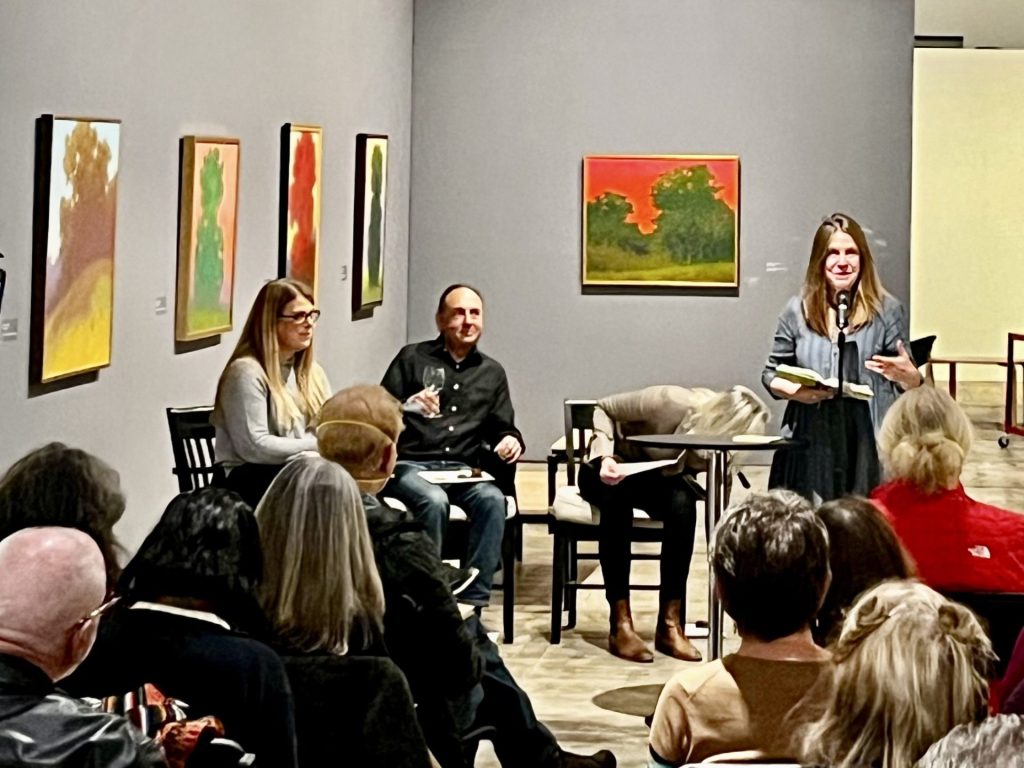
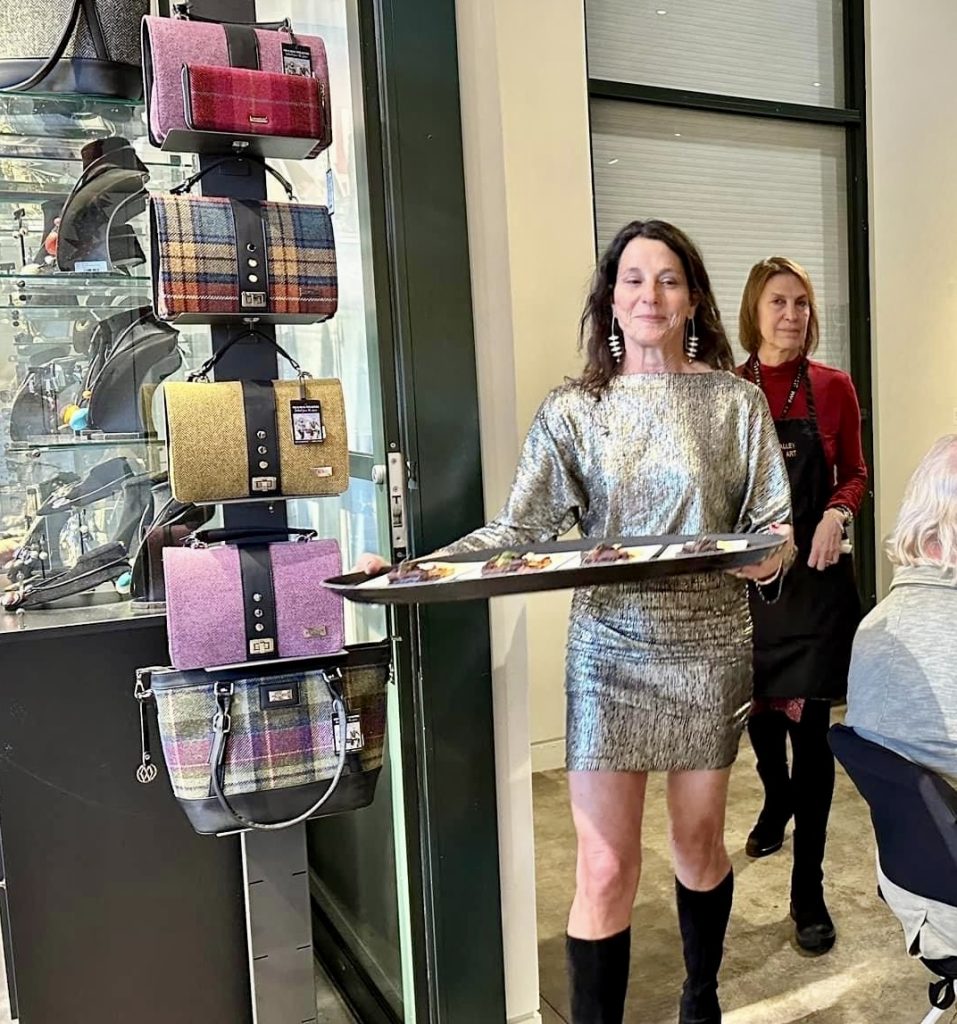
Sonoma International Film Festival
Named “One of the 25 Coolest Festivals” by MovieMaker Magazine and one of “America’s Top Ten Destination Film Festivals” by USA Today, and coming up on March 20th – 24th, 2024; all passes to the Sonoma International Film Festival are on sale right now. It is a fully park-and-walk festival with great venues, truly excellent films, delicious food, and first class wine. You don’t want to miss it!
The staff and board of the film festival gathered for our holiday party. Many of Sonoma’s non-profits were also represented. And as always, the event was hosted by Kevin and Rosemary McKneely, our most important and generous patrons.

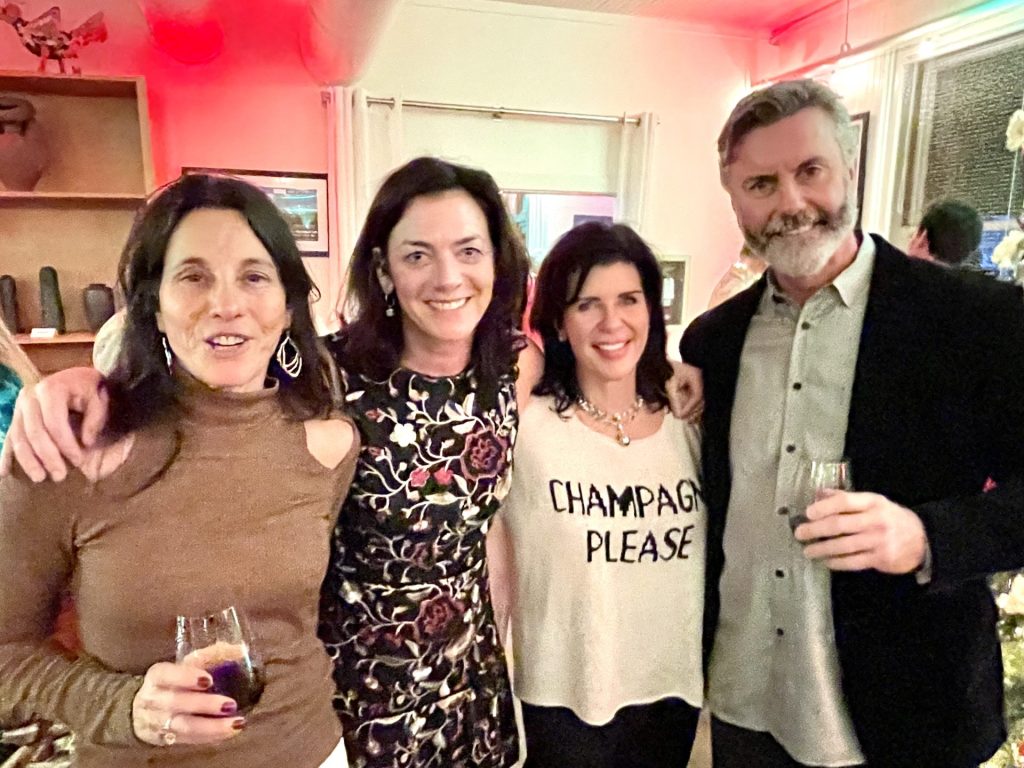
In the center, film festival board members Lisa Mango and Patty Elkus
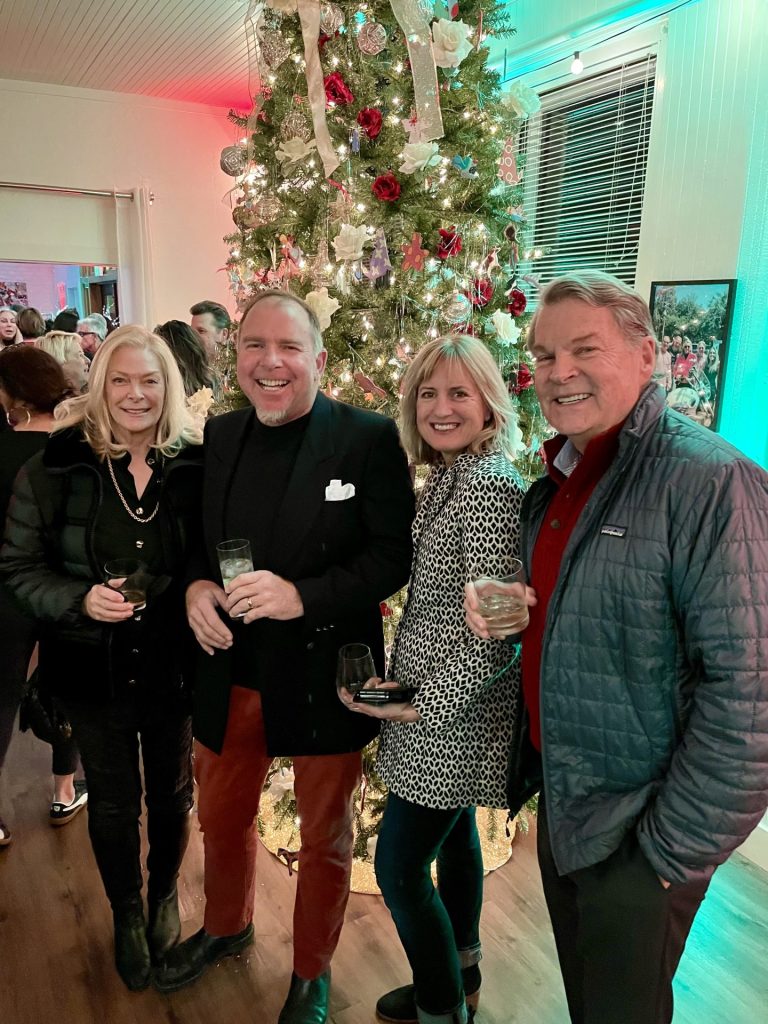
Film festival patrons
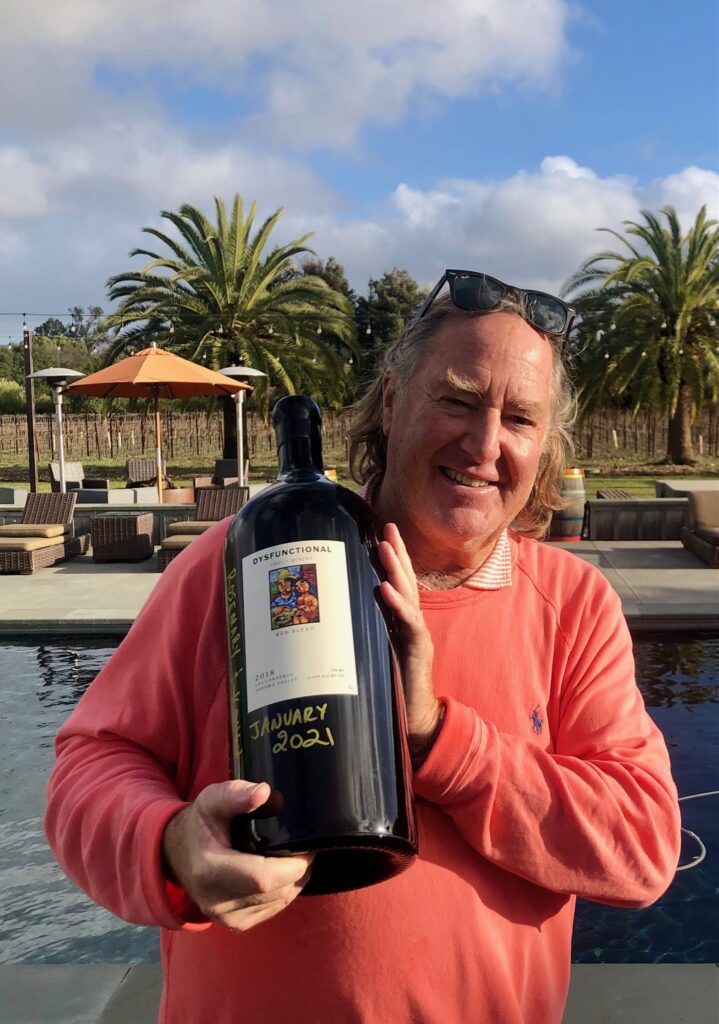
Kevin McNeely, Executive Director Emeritus of the Sonoma Valley International Film Festival, hoists a giant Methuselah of 2018 Dysfunctional Family Winery ‘Red Blend’, equal to 6 liters or 8 bottles. The SIFF film festival and Dysfunctional have teamed up several times for outdoor movie nights on the lawn, and we’ll return to that program someday soon.
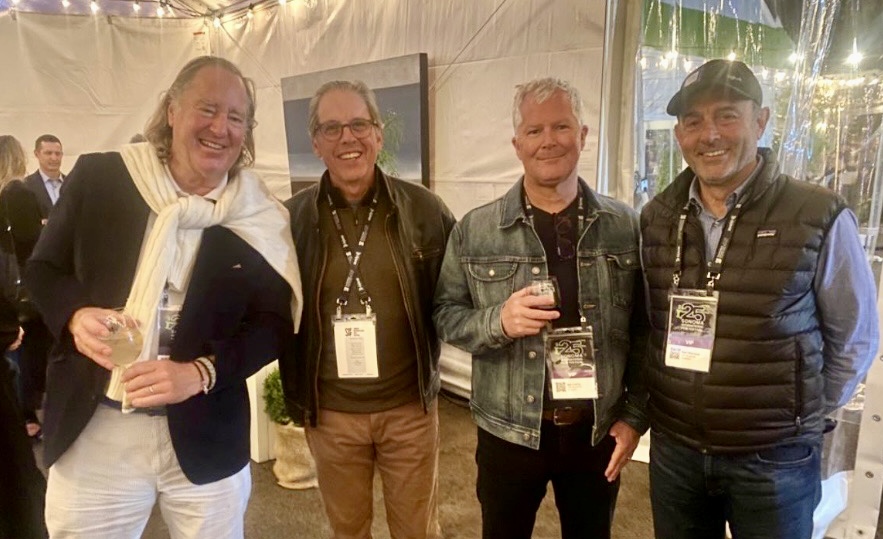
Sonoma International Film Festival – Kevin McNeely (Emeritus Creative Director), Bob Berg (Board Chair), John Curry (Emeritus Board Chair), and me, Ken Wornick (Board Vice-Chair)
Community Hanukkah
Supporting the Jewish community in their time of extreme stress, and for the right of Israel to exist, we attended a Hanukkah holiday event at the local Shir Shalom temple, then we cooked traditional potato latkes (don’t tell the cardiologists) and joined the larger Sonoma community for a public inter-faith community-wide menorah lighting and some street dancing too, on the last day of Hanukkah. The local Sonoma police and the County Sheriff’s offices blocked off a portion of Spain Street near the Plaza and provided a watchful vigil during the ceremonies, for which all attendees were quite grateful.
Below, winery client Patty Elkus submitted this beautiful image she titled “Lil Vignette of Santa and his Rosé” for the holidays. Seemed like just the right image for us to include with the Hanukkah story!
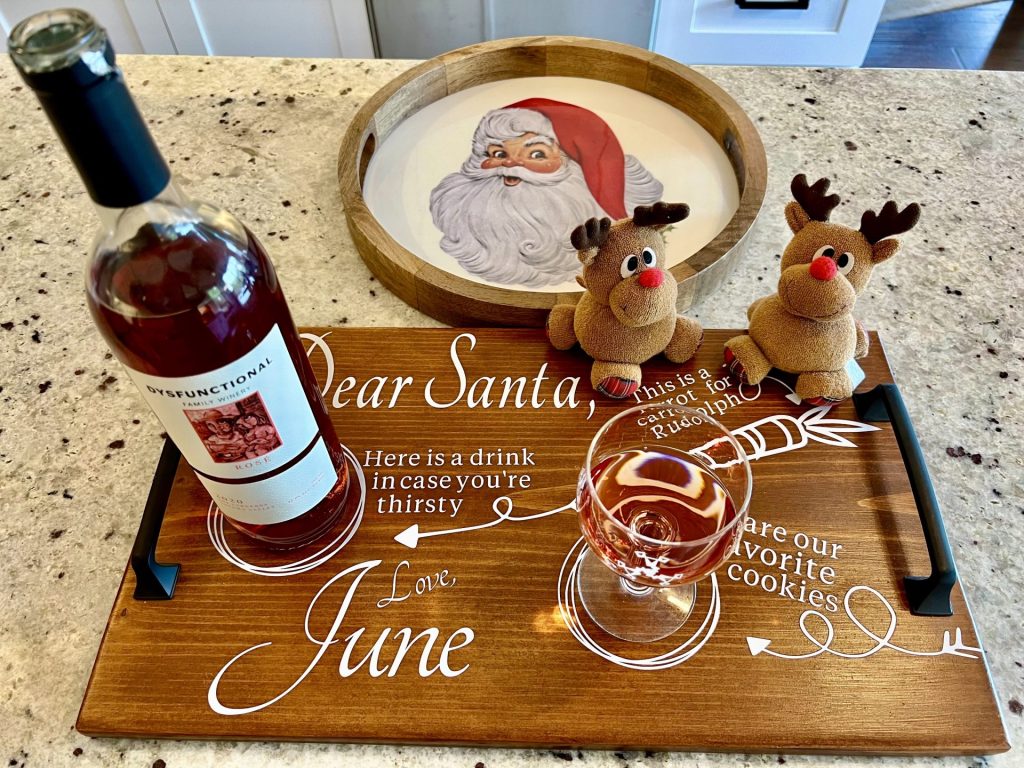
Bees and wax candle making
We put our Hydeout farm bee hives to bed for the winter, allowing the bees to build a seal around every crack and crevice of their hives, thus sheltering themselves from wind and rain and cold during the winter. Before that, we did the necessary hive work and collected some of the extra wax for various projects, seen here. I want to particularly thank Nic Freedman of Bees Rock Ranch and Chere Pafford, a renowned holistic bee keeper, both of whom acted as my mentors during this entire season.
Olives and oil
We harvested over a ton of Hydeout olives this year. Like everything on the farm, our approach is 100% organic. Due to last winters excellent rain, and the light crop in 2022, the 2023 crop was not only large, but nearly completely free of olive fruit flies. All in all a great olive harvest yielding deeply unctuous green oil.
Fall harvest – our final harvest of fruits and veggies from mid-December here at the farm
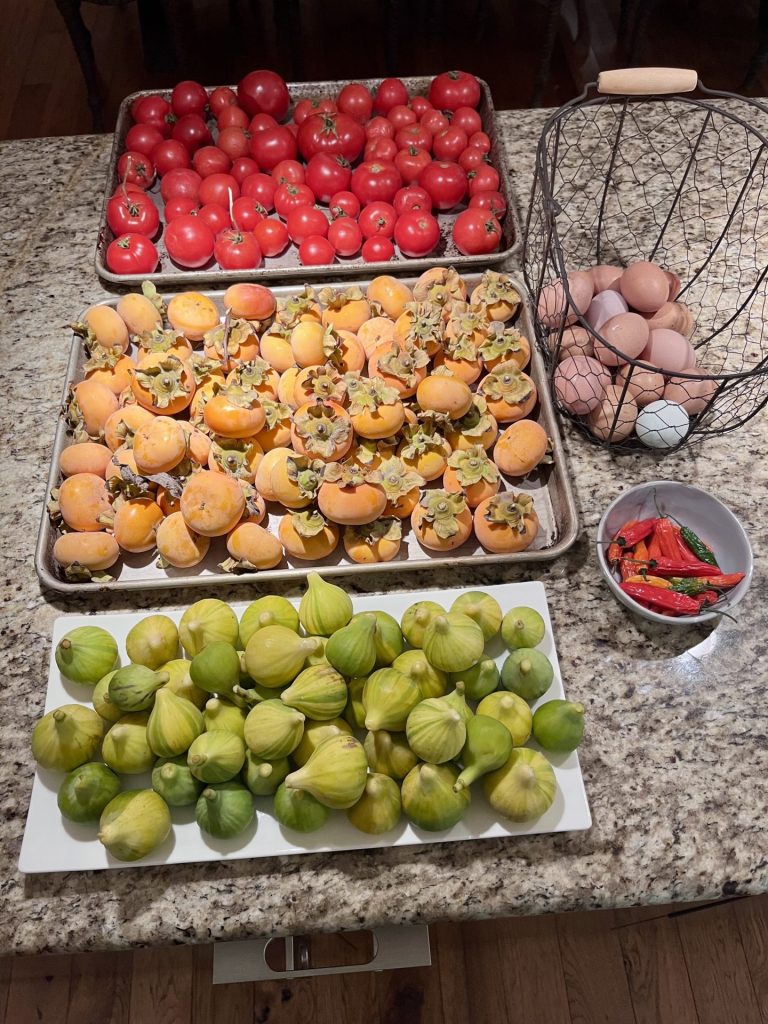
The very last of the tomatoes, persimmons, and figs picked just before the first rain (with a few peppers and some fresh eggs too).
What’s next for 2024?
The 2022 and 2023 vintages of Sagrantino are resting in barrels for the winter. The wild grasses and mustard are pushing up through the wet dirt from the recent three inches of rain. The winter solstice arrived on December 21st. Now the days get longer once again. We’ll prune the grape vines, mow the cover crop, and start in on another vintage. The 2024 vintage will be my 25th vintage.
Wishing all of you a wonderful New Year.
And when the holidays are done and things have returned to normal, we’ll still be here – ready to supply you with delicious wine. You can always order wine and pick it up at the winery. And we can ship too. Just click on this link! https://www.sonocaia.com
Happy new year everyone! – Ken
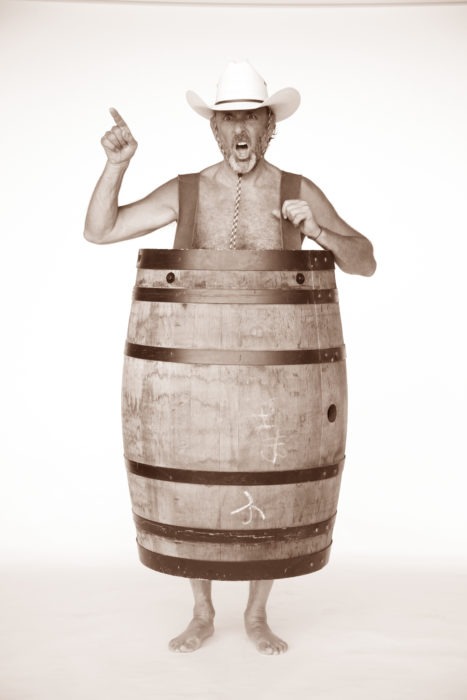
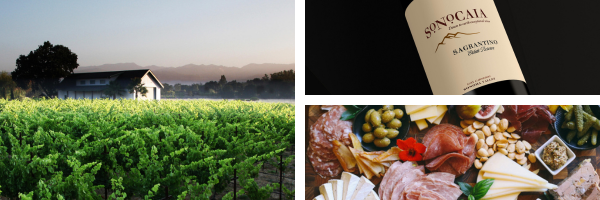
Sep 26, 2023 | Sagrantino, Sonocaia, Sonocaia Estate Vineyard, Sonocaia grand opening, Sonocaia Winery, Sonoma Farming, Sonoma wine tasting panel
Announcing the grand opening event of Sonocaia estate vineyard and winery
Join us for a delicious wine and food experience at our new Sonoma estate, Sonocaia (So-No-Kai-Yah). As one of our loyal Hydeout and Dysfunctional blog post readers, you get first shot to this event. Tickets will sell quickly. Three dates to choose from: Nov 3rd, 4th, and 5th.
Ticketed reservations are required. Seating is very limited. Your ticket includes our inaugural 2021 estate reserve Sagrantino, plus new and current releases, older library wines, and curated charcuterie. All set in our new winery.
Instructions: Click on the link, choose ONE of three dates, select number of tickets (max of 2) then ‘Add to Cart’ and proceed through checkout.
Sonocaia’s Inaugural Launch Event – click here for tickets
If you are unable to purchase tickets, that means the date is already sold out. Please try another date. Or email us at info@sonocaia.com. We will be keeping a first-come first-served waiting list. Special discounts for wines purchased at the tasting will be automatically affilliated with your ticket.
Sonocaia’s Inaugural Launch Event – click here for tickets
About Sagrantino: Our estate grown Sagrantino is a boutique-scale effort and one of only three wineries in the entire United States dedicated this variety. The Sonocaia Sagrantino is a traditionally-made deep red wine that transports tasters to the hills of Montefalco, Umbia, Italy. A rare find in California, this varietal is relatively unknown in the new world and is sparking curiosity from both the casual traveller and the serious wine critic. We have painstakingly cultivated this highly regarded Italian varietal with meticulous sustainable farming. The resulting wine makes a bold but very approachable statement. Think of Cabernet or Petite Sirah in complexity and structure, but with the body and finish of a softer wine. The nose offers enticing aromas of red and black fruits, dark chocolate, cedar, earth, savory herbs, and a touch of oak spice. On the palate the wine shows a rich, full body with a lovely, long-lasting finish. These features make Sagrantino a wine that will last nicely throughout an entire meal.
Sonocaia’s Inaugural Launch Event – click here for tickets
To learn more about our estate Sagrantino, click here
To read about all of our wines, click here
Pronounce it like this: SO-NO-KI-YAH SAG-RAN-TEEN-OH
We look forward to seeing you in November…
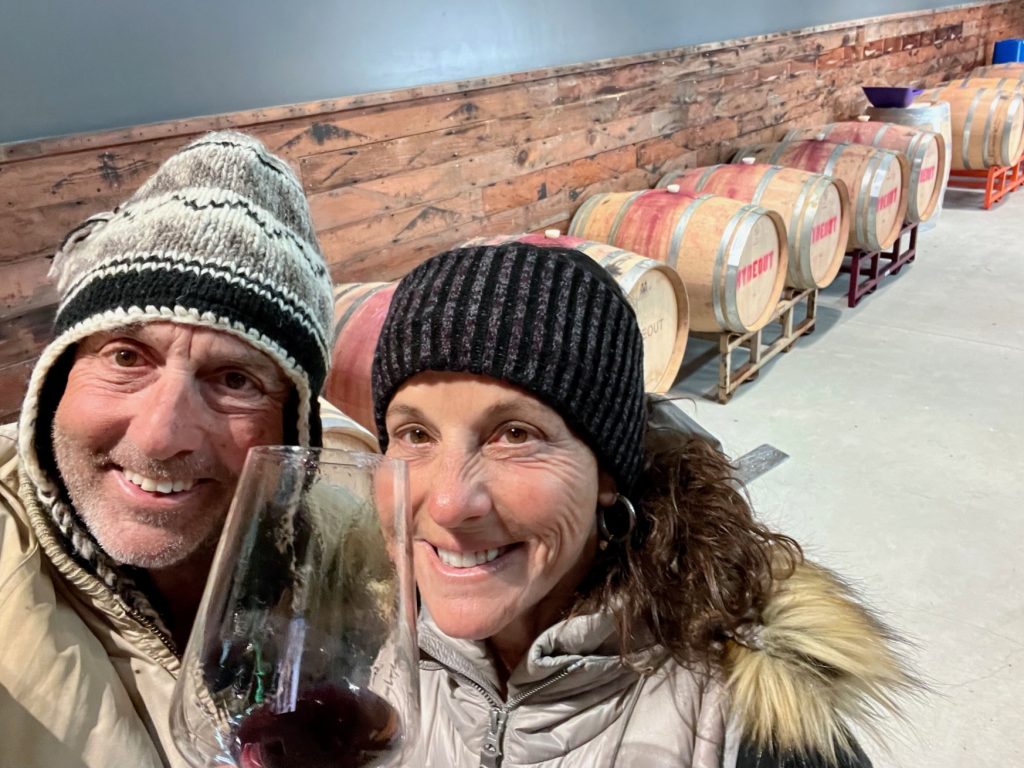
Ken and Cynthia in the new Sonocaia winery back in late winter of 2022 as construction is completed and oak barrels are moved in.
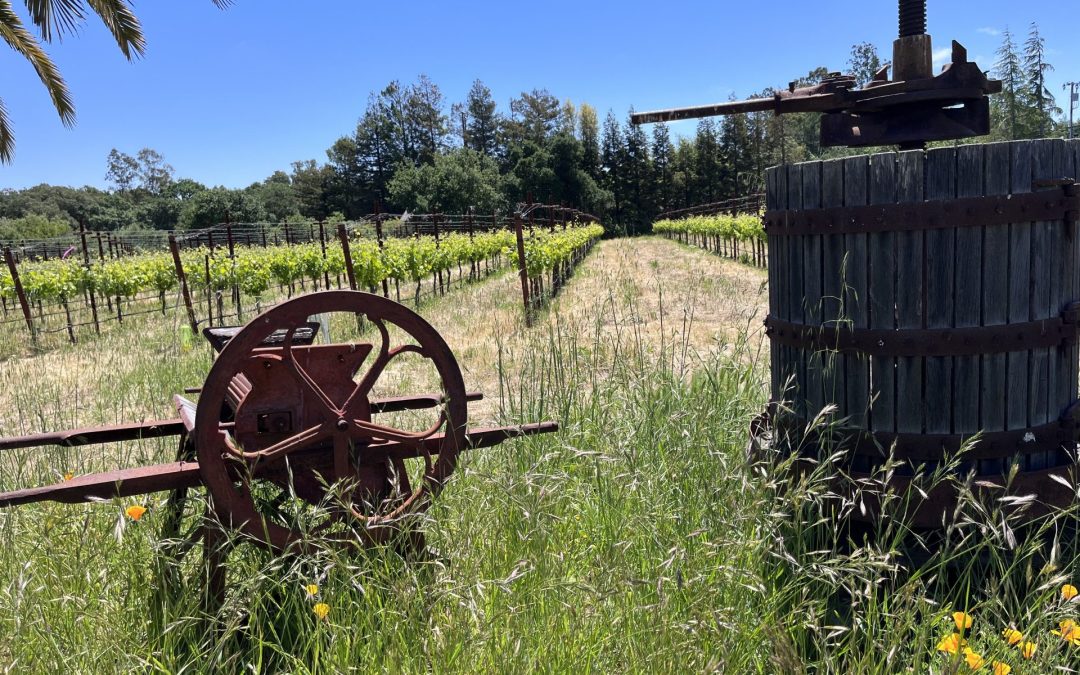
Jun 7, 2023 | Dysfunctional Family Winery, Hydeout Sonoma, Sagrantino, Sonoma, Sonoma Farming, Sonoma lifestyle, Sonoma Valley, Vineyard, Wine
Part 2 of farming and wine life in the Sonoma Valley…
Honey Bees and a National Park Ranger Talk on the Light Spectrum
Honey bees being a constant topic here at the Hydeout, what a great surprise to find a recent national park ranger talk on the color perception of bees! Turns out, honey bees see further out than humans on the light spectrum – which is why they can more easily find nectar in flowers. And why they don’t really like the color black.
Honey bees (cont’d)
Here are some more images of our work last week in the honey bees hives:
American Graffiti in Petaluma
This year marked the 50th year since George Lucas’ coming-of-age movie American Graffiti was released on the silver screen. Cruisin’ the Boulevard showcased hundreds of American model cars 1972 or older who joined in the annual parade of classic American cars cruising through the streets of downtown Petaluma where most of the movie was filmed in the summer of 1972. The best place to watch was along Petaluma Boulevard, south of B Street to D Street.
Fire
Sad to say we’ve had two fires already in our lovely Hyde-Burndale neighborhood. The first was a grass fire from some untimely afternoon high grass mowing. Our local neighbors with a water truck beat the firefighters to the scene (due to a faulty address) and had the fire out quickly.
The second, was a structure fire right across the street from us. The awesome and very local Schell-Vista Fire Dept arrived, followed closely by Cal-Fire, and that fire was also put out quickly. Hopefully the last of this fire business for the year.
Meal Fit for a King
Hosted by noted Napa vintner John Boich of Boich Cellars, we enjoyed an incredible food and wine event at their Wall Road vineyard (where we are farming Cabernet and Syrah for Boich). Check out the menu below for each of these incredible dishes:
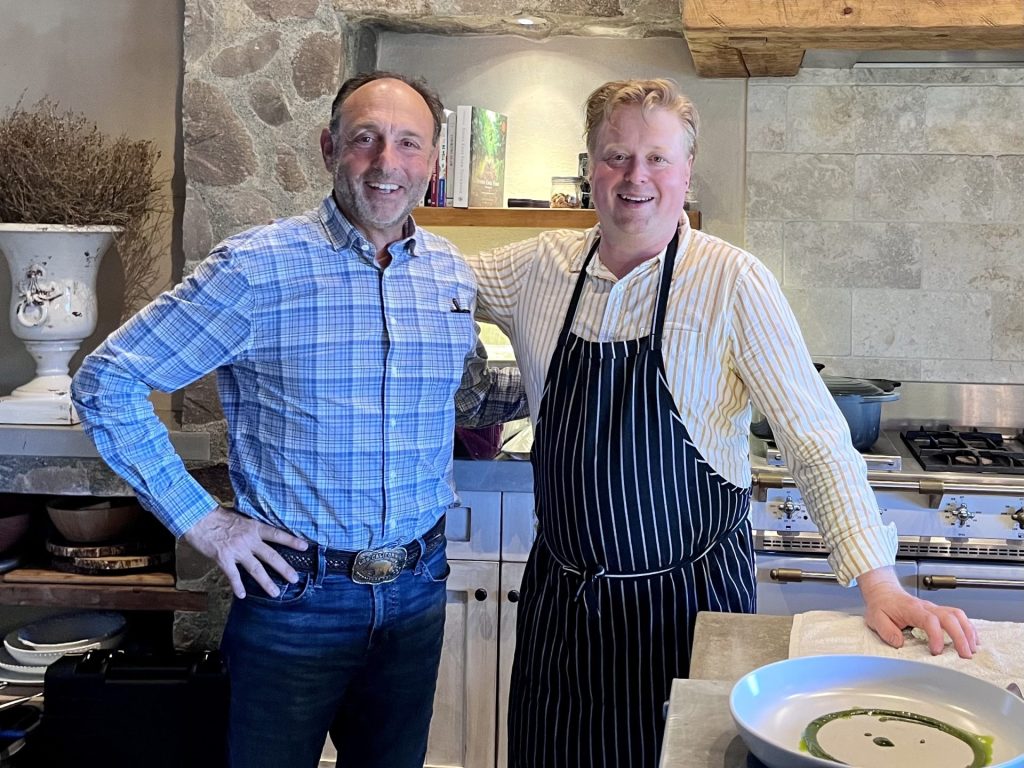
Yours truly, Ken Wornick, with chef extraordinaire Landon Schoenfeld of Oak and Acorn Luxury In-home Dining
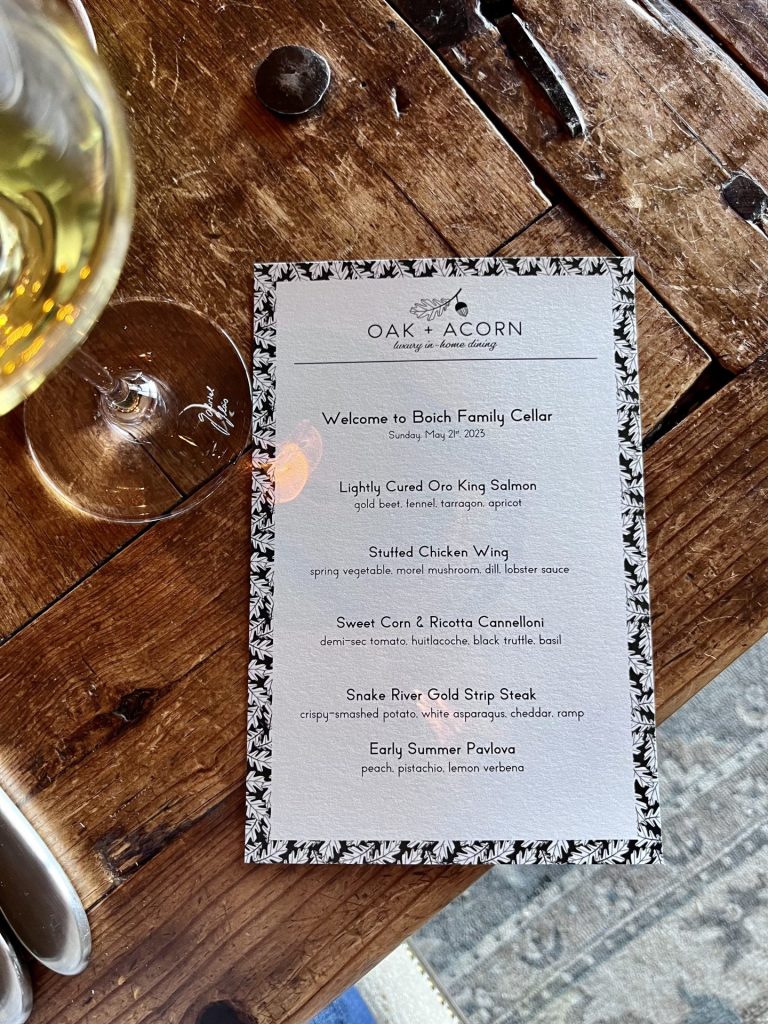
The Boich Cellars menu from Oak and Acorn Luxury In-Home Dining. Find them at 612-618-5909, oakandacorndining@gmail.com
Wildlife
After a very wet winter, wildlife activity is booming around Sonoma and at the Hydeout. These images, shot by professional photographer Michael Hodgson, Sony Pro photographer & travel journalist, at www.michaelhodgsonphoto.com and michael@hitraveltales.com
Snake!
This is first time ever finding a snake at the Hydeout. Snakes, especially rattle snakes are super common up in the hills around Sonoma. Down here in the almost-flats, we have very few to zero rattlers. This snake however is actually a common gopher snake that was leisurely crossing the driveway. I grabbed it, put it in a bucket, and took it straight out the vineyard where it very quickly disappeared down a gopher hole – to my very great delight!

Cork from Ganau, it’s Italian for cork
Our primary supplier of cork is Ganau, a local Sonoma company run by terrific people. In this video, you can see a natural product, cork, being naturally branded by fire. Click here to watch a 30-second video of cork being fire-branded at the Ganau plant

Fire branded and ink branded corks
Final thought…
Fun night at the Big Easy in Petaluma seeing Illegitimate AC/DC. Fronted by my buddies Bob Taylor (as Angus, center, guitar) and James Marshall Berry (right, on bass). They rocked hard all night long. Bob and James are also an integral part of KSVY Sonoma, our local radio station. I was a guest on Bob’s The Morning Show last week – check it out here: listen to Ken Wornick on the KSVY Morning Show

Next up – watch for a big announcement!
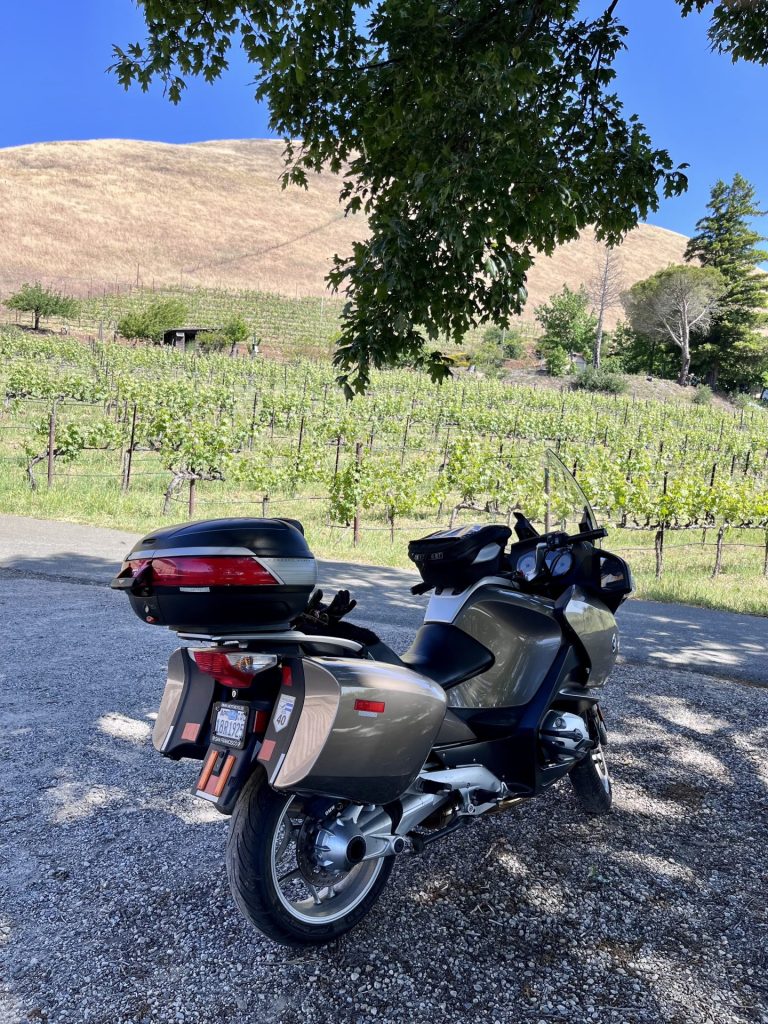
My trusty 2007 BMW R1200RT gets me around to all the vineyard sites we farm.
































